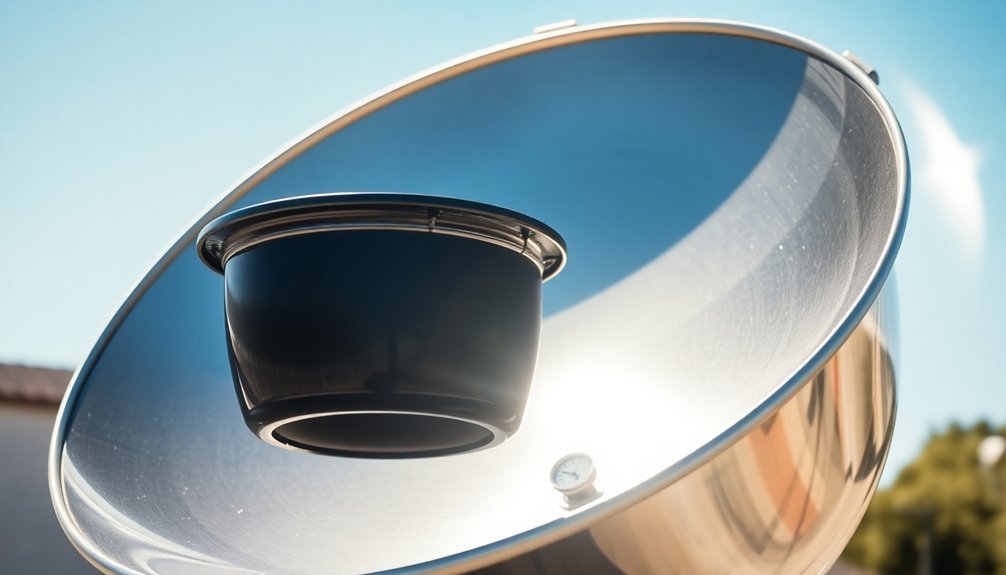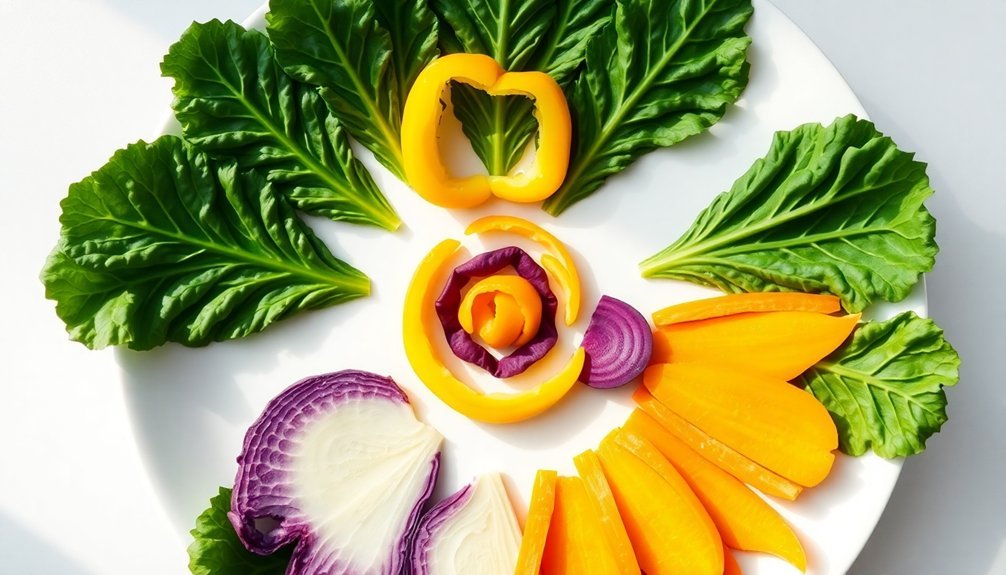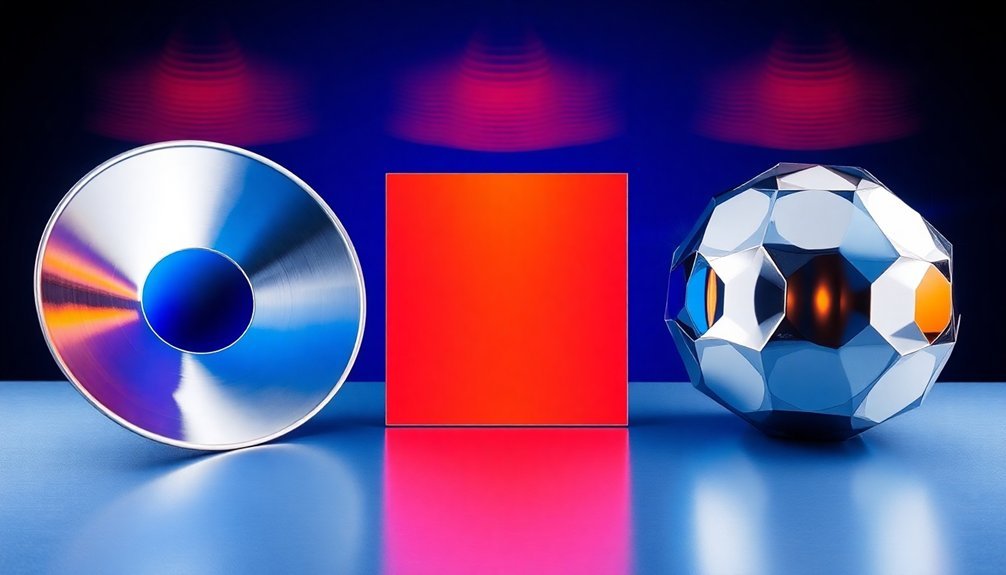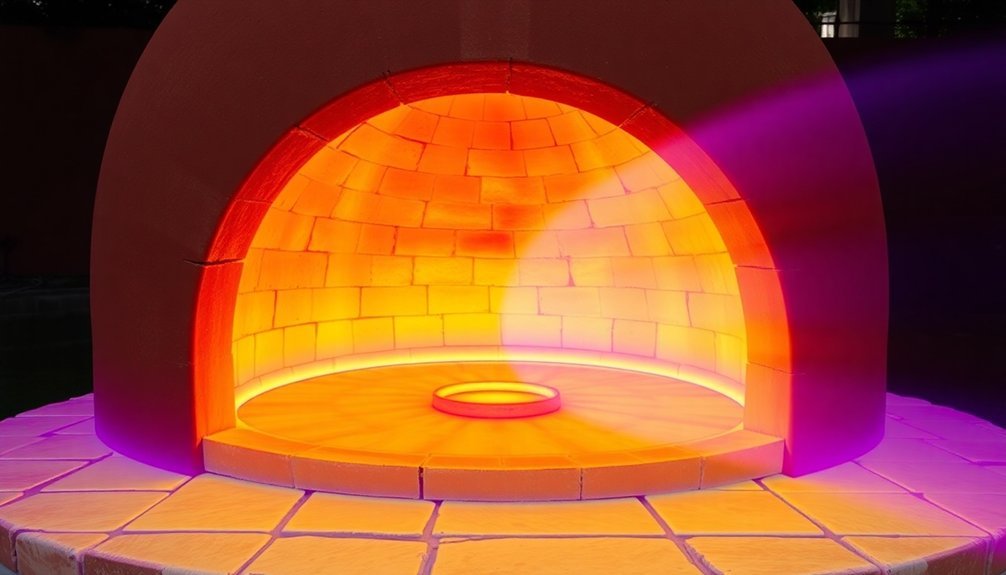Solar rice cookers must stay spotless to maintain peak cooking performance and food safety. You'll get maximum energy efficiency when reflective surfaces are free from dirt, smudges, and debris that can block sunlight absorption. Regular cleaning prevents bacterial growth that could contaminate your food while ensuring consistent heating temperatures reach 165°F for safe rice preparation. You'll also extend your cooker's lifespan by protecting components from damage caused by built-up grime. By keeping your solar cooker clean, you're not just maintaining equipment – you're maximizing its environmental benefits and your investment. There's much more to discover about proper solar cooker care.
Essential Equipment Care Basics

Proper care of your solar rice cooker's components guarantees its longevity and excellent performance. Regular upkeep helps extend the life of your investment. You'll need to establish a regular cleaning schedule based on how frequently you use your cooker and the environmental conditions it's exposed to.
When cleaning, select appropriate tools and methods that won't damage the sensitive components, especially the reflective surfaces and cooking chamber.
Pay close attention to the solution tanks and hoses in your solar cooker, as buildup and contamination can greatly reduce its efficiency. You'll want to inspect and tighten any loose bolts, screws, or fittings regularly to maintain peak performance.
Don't forget to check and replace filters as needed to guarantee proper airflow throughout the system.
Keep detailed records of your maintenance activities, including when you've cleaned specific components or made repairs. If you notice any issues during your regular inspections, address them promptly to prevent more serious problems from developing.
You should also make sure all seams are properly covered and sealed, as loose or exposed areas can decrease your cooker's efficiency and compromise its cooking performance.
Maximizing Solar Energy Collection
With careful attention to positioning and maintenance, you can considerably boost your solar rice cooker's energy collection capacity.
Start by strategically placing reflective materials like foil or mirrors to concentrate sunlight onto your pot, and make certain you're adjusting the cooker's angle throughout the day to track the sun's movement.
You'll want to focus on optimizing heat absorption by using black-colored surfaces inside your cooker and selecting heat-retentive materials for your cooking vessels. Remember to always unplug the unit before any maintenance work to ensure safety.
Keep the unit well-insulated and check regularly for gaps that might let precious heat escape. Position your pot precisely at the focal point where sunlight converges for maximum efficiency.
Don't underestimate the impact of regular maintenance on your cooker's performance.
You'll need to clean reflective surfaces frequently to prevent dust buildup that can notably reduce energy collection. Check for damage, secure loose components with aluminum tape, and make certain all seams remain tight.
Proper Heat Retention Methods

Successful solar rice cooking depends heavily on effective heat retention techniques. You'll need to focus on proper insulation and smart use of heat-trapping materials to guarantee your rice cooks thoroughly. Line your cooker with reflective materials like foil or black construction paper, and use materials such as hay, sawdust, or cotton waste around the cooking chamber. Studies show that larger portions of rice maintain cooking temperatures more effectively than smaller amounts.
| Heat Retention Method | Primary Benefit | Best Usage Time |
|---|---|---|
| Insulation Padding | Prevents heat loss | During cooking |
| Heat Retention Box | Maintains temperature | After solar exposure |
| Reflective Lining | Enhances heat absorption | Throughout cooking |
| Glazing Cover | Traps infrared radiation | Continuous use |
When clouds appear, you'll want to shift your cooking to a heat retention system. Transfer your rice pot to an insulated container or hay box, where it can continue cooking without additional energy input. You can also group smaller pots together with heated mass and insulation pads to maintain cooking temperature. For maximum efficiency, combine your solar cooker with other heat-retention methods like thermos flasks or fireless cookers. This integration guarantees you'll have perfectly cooked rice even when sunlight becomes limited.
Safe Food Preparation Standards
While mastering heat retention guarantees your rice cooks thoroughly, maintaining strict food safety standards protects your health when using solar cookers.
You'll need to follow essential hygiene practices when preparing rice, handling cookware, and storing leftovers to prevent foodborne illness.
Always start by washing your hands with warm soapy water for at least 20 seconds before handling any ingredients or equipment. Clean your solar cooker's pot, lid, and accessories with hot soapy water after each use, and make sure they're completely dry before storage.
When preparing rice, you'll want to maintain proper temperature control throughout the cooking process.
- Keep your raw ingredients separate from cooked rice to prevent cross-contamination
- Use a food thermometer to verify your rice reaches a safe internal temperature of at least 165°F
- Store any leftover rice in airtight containers and refrigerate below 40°F within two hours of cooking
- When reheating rice, verify it reaches at least 165°F throughout, and bring any rice-based soups to a complete boil
Clean your solar cooker's reflective surfaces regularly to maintain ideal heating efficiency and prevent bacterial growth in any food residue.
Extending Your Cooker's Life

Regular inspections of your solar rice cooker will help you spot potential issues before they become major problems.
You'll want to check the reflective surfaces and glass components monthly for signs of damage, dirt buildup, or deterioration that could affect cooking performance.
Clean and repair any damaged surfaces immediately to prevent further degradation and maintain your cooker's efficiency.
Regular Inspection Schedule
Longevity of your solar rice cooker depends heavily on following a structured maintenance routine.
You'll need to perform specific checks and cleanings at different intervals to guarantee your cooker operates at peak efficiency and maintains its durability over time.
Your daily maintenance should include wiping down the exterior with a damp cloth and cleaning the cooking pot with a non-abrasive sponge.
Don't forget to dry all components thoroughly before reassembling.
Weekly inspections focus on examining glass surfaces, reflecting panels, and position adjustment mechanisms for any signs of damage or malfunction.
For ideal performance, follow these essential inspection intervals:
- Daily: Clean after each use, removing food residue and wiping surfaces with mild detergent
- Weekly: Check reflecting surfaces, seals, and adjustment mechanisms for damage
- Monthly: Perform deep cleaning of all components, including steam vents and gaskets
- Annually: Schedule professional performance evaluation and conduct thorough testing
During monthly deep cleans, you'll want to soak stubborn stains and pay special attention to seals and gaskets.
Your annual check should include efficiency testing under various solar conditions and a detailed evaluation of the cooker's temperature maintenance capabilities.
Preventing Surface Deterioration
Maintaining your solar rice cooker's surfaces calls for careful attention to prevent deterioration and extend its lifespan. You'll need to focus on three key areas: reflective surfaces, insulation, and transparent materials.
For reflective surfaces, use a dry cloth to wipe them gently and avoid abrasive materials that could cause scratches. Regular cleaning prevents dust buildup that can reduce your cooker's efficiency. Keep these surfaces moisture-free to prevent damage and maintain peak reflectivity.
Your cooker's insulation requires a quality vapor barrier to prevent water damage. Install insulating materials like aluminum foil, feathers, or rockwool properly, ensuring there aren't any gaps or cracks that could let moisture escape. This helps maintain consistent heat retention inside your cooker.
The transparent materials need special care too. Whether you're using glass or plastic glazing, keep these surfaces clean and scratch-free to maintain solar transmittance. If you've opted for double glazing, you'll get better heat retention, but you'll need to inspect both layers regularly for damage.
When you're not using your cooker, store it indoors away from moisture and animals. On windy days, stabilize it with large stones or bricks to prevent damage.
Protecting Against Component Damage
Safeguarding your solar rice cooker's components against damage requires understanding how moisture affects different materials. When moisture infiltrates your cooker, it can compromise structural integrity, reduce insulation effectiveness, and diminish the performance of transparent surfaces.
You'll need to protect various materials like wood, cardboard, and metal from water damage that can cause warping, rotting, or rusting.
To maintain your cooker's efficiency and extend its lifespan, you should focus on these essential protective measures:
- Install high-quality seals and moisture barriers to prevent water vapor from escaping through gaps and reaching sensitive components.
- Clean and dry your cooker regularly, paying special attention to the glazing surface to guarantee maximum solar energy transmission.
- Check insulation materials frequently for signs of moisture buildup, as wet insulation can collapse and lose its effectiveness.
- Apply vapor barriers around insulation materials to prevent mold growth and maintain their insulating properties.
Remember that proper maintenance isn't just about cleanliness – it's about preserving the "greenhouse effect" that makes your solar rice cooker work efficiently.
Don't let moisture compromise your cooker's structural materials, insulation, or transparent surfaces.
Smart Environmental Impact Steps

Environmental stewardship with your solar rice cooker starts with understanding its potential for positive change. By using your cooker regularly, you'll prevent approximately one ton of wood from being harvested annually in sunny regions, directly fighting deforestation and soil erosion.
You're also helping eliminate greenhouse gas emissions that traditional cooking methods would produce.
You'll make a significant impact on indoor air quality when you switch to solar cooking. Traditional cooking methods contribute to indoor air pollution that claims 1.6 million lives yearly, with children under five being particularly vulnerable.
Your solar rice cooker produces zero harmful fumes or smoke, creating a healthier cooking environment for your family.
To maximize your environmental impact, make your solar cooker your primary cooking method whenever possible. You'll reduce your household's carbon footprint while saving money on utility bills.
Additionally, you're helping preserve forests by cutting your fuel wood needs by half. Remember that your cooking choice contributes to the potential prevention of over 30 million metric tons of CO2 emissions throughout the lifetime of solar cookers worldwide.
Frequently Asked Questions
Can I Use Regular Glass Cleaner on My Solar Cooker's Reflective Surfaces?
No, you shouldn't use glass cleaner on your solar cooker's reflective surfaces. It can damage the coating and leave harmful residues. Instead, use mild soap and water to safely clean the surfaces.
How Often Should I Replace the Black Absorber Plate?
You'll need to replace your black absorber plate every 5-10 years, but inspect it every 6-12 months. If you notice cracks, peeling, rust, or considerably longer cooking times, replace it immediately.
Will Cooking Acidic Foods Damage My Solar Cooker's Interior?
Yes, acidic foods can damage your solar cooker's interior, especially if it's made of aluminum. You'll need to use non-reactive cookware like enamel-coated pots and clean thoroughly after each use to prevent material degradation.
Does Humidity Affect How Frequently I Need to Clean My Cooker?
Yes, you'll need to clean your cooker more often in humid conditions. High humidity causes faster moisture buildup, which can lead to bacterial growth and corrosion. You should also wipe condensation regularly from the glass lid.
Can I Use Abrasive Cleaning Pads on Tough Stains?
No, you shouldn't use abrasive pads on your rice cooker. They'll damage the non-stick coating and sensitive components. Instead, use soft sponges and warm, soapy water to tackle tough stains safely.
In Summary
Keep your solar rice cooker spotless to guarantee it performs at its peak. You'll maximize sunlight absorption through clean reflective surfaces, maintain proper heat levels, and prevent harmful bacteria growth. By following regular cleaning routines, you're protecting your investment, guaranteeing safe food preparation, and promoting eco-friendly cooking. Don't let dirt compromise your cooker's efficiency – a clean unit means better meals and longer-lasting equipment.





Leave a Reply